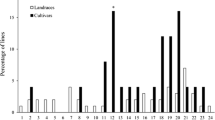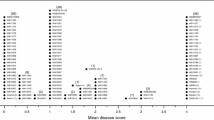Abstract
One hundred and twenty-one of 123 previously detected new sources of wild barley (Hordeum vulgare ssp. spontaneum) resistant to powdery mildew (Blumeria graminis f. sp. hordei), and originating from Mediterranean area, and 20 standards were tested at the seedling stage for reaction to 38 selected Israeli powdery mildew isolates. The obtained resistance spectrum (a set of resistant and susceptible reactions) of each accession was divided into triplets and converted to octal numbers. This concentrates information on the resistance phenotype of each accession and makes their comparison much easier. One hundred and thirty-four different resistance spectra were determined. No compatible reaction was found in standards possessing genes mlo and Mlhb2 and in the accession PI 466634. The results demonstrate large diversity in new resistance sources, their distinction from the sources described till now as well as diversity in powdery mildew resistance of wild barley in the Mediterranean area. The results facilitate more effective further studies of such a large set of new resistance sources, and contribute to speeding up their use in barley breeding.
Similar content being viewed by others
References
Baum B.R., Nevo E., Johnson D.A. and Beiles A. 1997. Genetic diversity in wild barley (Hordeum spontaneum C. Koch) in the Near East. a molecular analysis using Random Amplified Poly-morphic DNA (RAPD) markers. Genetic Resources and Crop Evolution 44: 147-157.
Dinoor A. and Eshed N. 1984. The role and importance of pathogens in natural plant communities. Annual Review of Phytopathology 22: 443-466.
Dinoor A. and Eshed N. 1987. The analysis of host and pathogen populations in natural ecosystems. In: Wolfe M.S. and Caten C.E. (eds), Populations of Plant Pathogens: their Dynamics and Genetics. Blackwell Scientific Publications, Oxford, pp. 75-88.
Dreiseitl A. and Bockelman H.E. 2002. Sources of powdery mildew resistance in a wild barley collection. Genet. Resour. Crop Evol. (in press).
Gilmour J. 1973. Octal notation for designating physiologic races of plant pathogens. Nature 242: 620.
Hermann A., Lower C.F. and Schachtel G.A. 1999. A new tool for entry and analysis of virulence data for plant pathogens. Plant Pathology 48: 154-158.
Jahoor A. and Fischbeck G. 1987. Sources of resistance to powdery mildew in barley lines derived from Hordeum spontaneum collected in Israel. Plant Breeding 99: 274-281.
Jahoor A. and Fischbeck G. 1993. Identification of new genes for mildew resistance of barley at the Mla locus in lines derived from Hordeum spontaneum. Plant Breeding 110: 116-122.
Jørgensen J.H. 1992. Discovery, characterization and exploitation of Mlo powdery mildew resistance in barley. Euphytica 63: 141-152.
Jørgensen J.H. 1994. Genetics of powdery mildew resistance in barley. Critical Reviews in Plant Sciences 13: 97-119.
Kintzios S., Jahoor A. and Fischbeck G. 1995. Powdery-mildew-resistance genes Mla 29 and Mla 32 in H. spontaneum derived winter-barley lines. Plant Breeding 114: 265-266.
Lewontin R.C. 1974. The Genetic Basis of Evolutionary Change. Columbia University Press, New York.
Limpert E., Clifford B.Z, Dreiseitl A., Johnson R., Muller K., Roelfs A. et al. 1994. Comparing systems of designation of pathotypes of plant pathogens. Journal of Phytopathology 140: 359-362.
Nevo E. 1998. Genetic diversity in wild cereals. regional and local studies and their bearing on conservation ex situ and in situ. Genetic Resources and Crop Evolution 45: 355-370.
Nevo E., Baum B., Beiles A. and Johnson D.A. 1998. Ecological correlates of RAPD DNA diversity of wild barley, Hordeum spontaneum, in the Fertile Crescent. Genetic Resources and Crop Evolution 45: 151-159.
Nevo E., Zohary D., Brown A.H.D. and Haber M. 1979. Genetic diversity and environmental associations of wild barley, Hormildew deum spontaneum, in Israel. Evolution 33: 815-833.
Schonfeld M., Ragni A., Fischbeck G. and Jahoor A. 1996. RFLP mapping of three new loci for resistance genes to powdery mildew (Erysiphe graminis f. sp. hordei) in barley. Theoretical and Applied Genetics 93: 48-56.
Steffenson B.J. 1998. Coordinators report. Disease and pest resistof ance genes. Barley Genetics Newsletter 28: 95-98.
Torp J., Jensen H.P. and Jørgensen J.H. 1978. Royal Veterinary and Agricultural University Yearbook. Copenhagen, Powdery mildew resistance genes in Northwest European spring barley varieties. p.p. 75-102.
Xu J. and Kasha K.J. 1992. Transfer of a dominant gene for powdery mildew resistance and DNA from Hordeum bulbosum into cultivated barley (H. vulgare). Theoretical and Applied Genetics 84: 771-777.
Author information
Authors and Affiliations
Rights and permissions
About this article
Cite this article
Dreiseitl, A., Dinoor, A. Phenotypic diversity of barley powdery mildew resistance sources. Genetic Resources and Crop Evolution 51, 251–257 (2004). https://doi.org/10.1023/B:GRES.0000024010.12369.b3
Issue Date:
DOI: https://doi.org/10.1023/B:GRES.0000024010.12369.b3




